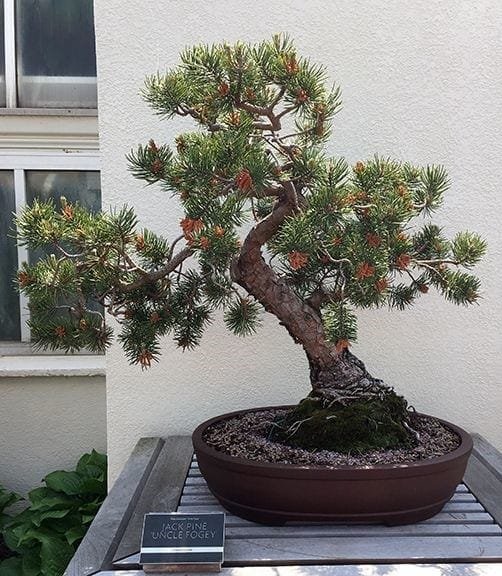Jack pine is a wonderful variety to make a part of the art of bonsai – being such a hardy tree, it is also fairly suitable for beginner bonsai enthusiasts.
With a mind to all our fellow bonsai gardeners, we have compiled a jack pine bonsai care guide that aims to highlight all the important details that will help you make the most from your bonsai journey.
Facts about Jack Pine Trees

Jack pines are native species to Canada and the northern US.
Naturally, Jack pine manage to grow in areas where most other plants simply won’t survive – for example, sandy and rocky hills.
In the wilds, Jack pine trees can reach 200 years old. The size of these stunning evergreen trees varies from three to seventy-five feet.
The main part of the root system of Jack pine trees consists of lateral roots that cover the upper layers of the soil.
Scientifically known as Pinus banksiana, there are over 75 Jack pine species – and each of these is named for the British botanist Sir Joseph Banks.
With a beautiful bark that develops mesmerizing cracks over time, Jack pine is one of the most beloved types of trees used in the art of bonsai.
Video by ESFTV – Trees with Don Leopold – jack pine
Source: youtube.com
Taking Care of Jack Pine Bonsai: Step-by-Step Guide

1 – Choosing the Best Soil for Jack Pine Bonsai
Jack pine bonsai trees prefer soil that possesses a neutral pH balance or is only slightly acidic.
In fact, the soil becomes naturally slightly acidic where Jack pine grows because of the positive feedback between trees and soil.
A high-quality conifer mix that consists of equal parts pumice, akadama and lava rock along with ½ less of equal parts de-composted granite and charcoal.
Opting for adding as much as 50% of sand to the soil can work fine but remember that higher quality ingredients bring life to higher quality bonsai trees.
2 – Best Light for Jack Pine Bonsai Trees
As briefly mentioned above, Jack pine trees naturally grow in a rocky, sandy environment in the wilds.
What is common for its natural environment is that there is an abundance of light. Grow Jack pine bonsai trees in a spot that has an abundance of light and avoid shady spots.
3 – Re-potting Jack Pine Bonsai Trees
Be careful with the root system of Jack pine bonsai trees because of the lateral growth that can be easily harmed.
Re-potting should take place every five years or every other year. With this in mind, Jack pine bonsai trees take a long time to grow and patience is crucial.
Also, make sure to re-use some of the soil when re-potting as not to harm the mutually beneficial relationship of your Jack pine bonsai tree with Myccorhizal fungi flourish.
4 – Watering Jack Pine Bonsai Trees
Even though Jack pine trees in the wilds are highly resistant to drought, careful watering of your Jack pine bonsai is crucial.
It is best to provide a decent amount of water but avoid going over the top of the soil. Nevertheless, you should allow the soil to dry out fully before watering again.
5 – Fertilizing Jack Pine Bonsai Trees
As a rule of thumb, slightly acidic fertilizers work best when growing a Jack pine bonsai tree.
You should restrain from fertilization during the winter season in favor of a beneficial fertilizing schedule during the autumn season.
6 – Pruning and Training Jack Pine Bonsai Trees
The moment when you know that your Jack pine bonsai is ready for more pruning or training is noticing new, vigorous growth.
For the rest of the time, avoid wounding, wiring, bud removal, and reduction of foliage, among others, as not to shock your Jack pine bonsai to the point of stunting its growth.
In order to achieve the best results, remind yourself that patience is key –pruning and training only once a year will work great as long as you apply these methods properly.
7 – Growing Jack Pine Bonsai and Pests Control
As with all plant species, Jack pine trees can be attacked by various pests, some of the most common ones being borers, weevils, and aphids.
Check regularly for any signs of nasty, tiny intruders and act accordingly. When treated in a timely manner, pests won’t be able to cause irreversible damage to your Jack pine bonsai.
Video by Tree Flower and Plants – Jack Pine Bonsai
Source: youtube.com
Final Thoughts

To wrap-up all the best practices in growing Jack pine bonsai, remember that you have a lot of freedom – but that doesn’t mean you should go too hard on your Jack pine bonsai tree.
Avoid styles that are not natural to Jack pine trees, such as broom, upright, and formal styling. Be patient and let the tree work with you
Taking care of a Jack pine bonsai is a beautiful journey full of joy and invaluable lessons that can help you become a better person – and this is nothing less but amazing. Hopefully, along with some help from the carefully-curated Jack pine bonsai care guide, you are only one step away from indulging in the pleasure of being a bonsai tree gardener.


